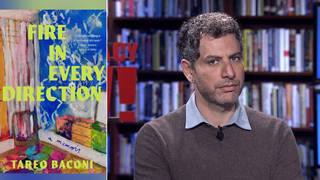
We speak with The Guardian’s chief reporter Ed Pilkington about the shocking double execution Arkansas carried out Monday night, marking the first time in nearly 17 years that any state has killed two people on the same day. At 7:20 p.m. local time, 52-year-old Jack Harold Jones was pronounced dead in the death chamber at the Cummins Unit state prison. Infirmary workers had spent more than 45 minutes unsuccessfully trying to put a central line into his neck. According to a court filing, during Jones’s execution, he was “moving his lips and gulping for air,” which suggests he continued to be conscious during the lethal injection. Lawyers for the second man, Marcel Williams, filed a last-minute appeal for a stay of execution following Jones’s killing, arguing Williams could also experience a botched, painful death. A district court judge initially granted a temporary stay of Williams’s execution but then allowed the execution to go forward. Williams was pronounced dead at 10:33 p.m. The executions came after legal challenges reached the U.S. Supreme Court, which rejected a stay for Williams. The only justice to dissent in this ruling was Justice Sonia Sotomayor. The last double execution carried out in the United States was in 2000 in Texas.
Transcript
JUAN GONZÁLEZ: Arkansas carried out a double execution Monday night, marking the first time in nearly 17 years that any state has killed two people on the same day. At 7:20 p.m. local time, 52-year-old Jack Harold Jones was pronounced dead in the death chamber at the Cummings Unit state prison. Infirmary workers had spent more than 45 minutes unsuccessfully trying to put a central line into his neck. According to a court filing, during Jones’s execution, he was, quote, “was moving his lips and gulping for air,” unquote, which suggests he continued to be conscious during the lethal injection. The controversial sedative midazolam is administered as part of a cocktail of execution drugs to make prisoners unconscious, but it’s repeatedly failed to do so during other executions, leading to painful deaths. Ahead of Monday night, Jones’s lawyers had argued his medical condition was likely to reduce the sedative’s effectiveness, leading to an unconstitutionally painful death, but this argument was rejected by a court. Before being killed, Jones gave a long final statement in which he apologized to the daughter of Mary Phillips. Jones has admitted to raping and killing Mary Phillips in 1995. His final words were “I’m sorry.”
Lawyers for the second man, Marcel Williams, filed a last-minute appeal for a stay of execution following Jones’s killing, arguing Williams could also experience a botched, painful death. A district court judge initially granted a temporary stay of Williams’s execution but then allowed the execution to go forward. Williams was pronounced dead at 10:33 p.m. He had been convicted and sentenced to death for the 1994 kidnap, rape and murder of Stacy Errickson.
AMY GOODMAN: Monday night’s executions came after legal challenges reached the U.S. Supreme Court, which rejected a stay for Williams. The only justice to dissent in this ruling was Justice Sonia Sotomayor. The last double execution carried out in the U.S. was in 2000 in Texas. Arkansas carried out its first execution in 16 years Thursday, killing Ledell Lee, and plans to execute a fourth man, Kenneth Williams, this coming Thursday. The state had initially planned execute eight people within 11 days this month—an unprecedented rate of executions in modern U.S. history. They wanted to perform these executions before the end of the month, when midazolam would expire.
For more, we’re joined via Democracy Now! video stream by The Guardian reporter Ed Pilkington, who has been following the executions closely with local reporters on the ground.
Ed, welcome back to Democracy Now! You have a witness statement on the execution. Can you explain—there were two—what the witness saw?
ED PILKINGTON: Yeah. We worked with Jacob Rosenberg, who is a reporter for Arkansas Times. He was in the death chamber for the second execution last night, of Marcel Williams. And a very interesting account, I think, really important part of it—there are two things, really. One, because of the court’s stay that happened for Marcel Williams, while the judge considered what had happened to the first prisoner to die, Jack Jones, Marcel Williams was kept strapped to the gurney the entire time. Now, we don’t quite know when that began. It’s probably around something like 8:00 p.m. last night. And he was pronounced dead at 10:33. So, for maybe longer than two-and-a-half hours, this 400-pound prisoner was kept strapped to a gurney, which I think is fairly disturbing in itself.
The other thing that came out of our eyewitness report is that there’s a sort of missing half an hour. Now, the media—the three media witnesses were kept held in a van while this—the delay was happening because of the court proceedings. They had a little window at the back of the van that they could look out the back of. They saw Marcel Williams being taken out to the bathroom and then brought back. He was brought back at about 9:29. The execution began at 10:16. We don’t know anything about what happened in that period. And I think that’s important and will continue to be important, and it’s because of the secrecy that the death penalty states have imposed on the entire process of execution. The media witnesses were only allowed to see when the curtain was opened and the execution began. They were not allowed to see the crucial period in which IV lines were tried to be found. And that was a problem that we had in the Jack Jones execution earlier in the evening. The state, by its own admission in court filings, admitted that they tried to find an IV line in the prisoner’s neck and failed.
And this is precisely the kind of problems that have come up time and time again, with Clayton Lockett, the gruesome execution in Oklahoma where he writhed for 43 minutes on the gurney—that was down to an IV line that couldn’t be found—and in Arizona, the Wood execution, where they tried—they stuck him 15 times and injected him 15 different times, because they found it so difficult to find a vein. So, I think we’re starting to see the same old problem emerge yet again: secrecy, the fact that the public cannot see what’s being done in its name when prisoners are being killed, leading to problems in the process.
JUAN GONZÁLEZ: And, Ed Pilkington, what are the requirements in terms of the public’s ability to view this, or the witnesses, at least, who are there, who are permitted to see the execution, being able to witness the entire process?
ED PILKINGTON: Well, that’s the problem. Like so much to do with the death penalty, it’s down to each individual state. But there is something in common here. And that is, all the death penalty states, all sort of nine or so of them that are still being—actively trying to pursue the death penalty, have taken the same line, which is, we should let the public know as little as possible. So they don’t let us know the members of the execution team. Now, maybe that’s understandable, because, you know, the executioners could face harassment. But they won’t let us know who manufactures the drugs they use or where they got them from. And that’s problematic because we don’t know, you know, were these drugs sort of knocked up in a corner shop. They have tried that in the past. And now they’re fighting over how much the public can see in the process.
And in Arkansas, they went to extraordinary lengths to make our job difficult as reporters—and I’m one of them. To start with, they wouldn’t even allow us laptops into the media room, where we were watching if we weren’t in the death chamber. Now, this is just a visiting room. We’re not anywhere near the death chamber. We’re not a security issue. We weren’t allowed laptops, to start with. They consented on that in the end, but we weren’t allowed telephones in the room. And in the end, they only allowed reporters to take in notepads and pencils supplied to them by the prison service, as though there was something like a reporter would carry in their own notebook that would do something subservient or something. And the whole process has like been a battle between the media, which is the eyes and ears of the public, and the prison service, that, after all, is doing the most serious thing that any state can do, and that is to kill one of its own citizens.
AMY GOODMAN: I wanted to ask you, Ed Pilkington, about the deputy solicitor general, named Nicholas Bronni, who admitted in a court filing the execution team had tried to place a central line in Jones’ neck, but the attempt was unsuccessful. Talk about the significance of this and what happened next, and that leading to the lawyers for the next man, Marcel Williams, trying to get a stay on his execution, so he would not be tortured as he was killed.
ED PILKINGTON: Right. And, I mean, when I saw that in the court filing coming from the state itself, I was astonished. They were trying to rebut the case made by the lawyers for the second prisoner to be executed, Marcel Williams, that the first execution had been botched. That’s what essentially was going on. And in order to rebut that argument, the state said, “No, everything was fine. Look, we tried to find an IV line in Jack Jones’, the first prisoner’s, neck, and we failed. And then we went on. We actually decided not to use a third IV line. We would just use two.” Now, they made that argument as though that showed that the whole process had been a success, which I found rather astonishing when I read it in the court filing.
Then we went on to the Marcel Williams execution, the second one. We don’t know, as I say, what happened in half an hour when they were trying to find an IV line. We know nothing about that at all. What we do know, from The Guardian's work with the Arkansas Times and the reporter who was in the room for us, Jacob Rosenberg, that Marcel Williams was seen to do—once he was sedated with midazolam—which, you have to remember, is a sedative, it's not an anesthetic, which is—it is not used in operations to put people under before surgery. It is just used to relax them. So it’s an entirely inappropriate medicine for use in surgeries, and you might, therefore, say inappropriate for use in executions. They gave him the midazolam. He relaxed. He started to breathe very heavily. Now, our reporter from the Arkansas Times saw him rise up and down. His back arched countless times. He actually lost count of the number of times his back arched. This lasted over just a relatively short period of time, for about five, six minutes, compared with some of the really botched executions we’ve seen, say, of Clayton Lockett, which was 43 minutes. But nevertheless, it suggests that maybe the prisoner was experiencing difficulty. And again, will we ever find out anything more about that? There is no indication that Arkansas carried out an official inquiry into what happened. Often it takes months, if at all, to see the internal results of their own inquiries. The whole process is shrouded in secrecy, and it makes it very, very difficult for the media and for the public to assess exactly what happened.
JUAN GONZÁLEZ: And, Ed Pilkington, you’re the chief reporter for The Guardian US. Briefly, in the few moments we have left, could you tell us what’s the response in Britain and in Europe, in general, to this continuing obsession in the United States with executions?
ED PILKINGTON: Well, it’s been very widespread coverage and quite a lot of anger and dismay. I mean, it comes at a time when the world had been thinking that the death penalty was receding, was on the wane in the U.S. Last year, there were only 20 executions. And it has been going steadily down. Then, suddenly, a Republican governor in Arkansas decides that he needs, for his own reasons, all to do with the supplies of medicines, nothing else—for his own reasons, he needs to execute eight prisoners in 11 days. And, bam, the whole thing is back. And Europe and Britain are incensed again. And here we are, talking about it all over again.
AMY GOODMAN: Finally, Ed Pilkington, what happens next? I mean, for people to understand, who are watching this around the globe, the reason there are what they call these doubleheader executions now in Arkansas, to—they attempted to kill—some were stopped in the killing—eight men in 11 days, was to hit that deadline by the end of the month, when the—one of the execution drugs, midazolam, expires by the end of the month. So, who’s on—who is on the list next to be killed?
ED PILKINGTON: Well, we’ve got one more execution coming up this Thursday in Arkansas. And then, sort of the battle continues. You have to say that the death penalty states are waging a losing battle here, because the drug companies are now absolutely in unison. They do not want their drugs, which are designed and manufactured to save lives—they do not want those drugs used to kill people. They’re all saying it. More than 30 of the major manufacturers are now saying that. Distribution companies are also saying that. They do not want this to happen, and they are making it incredibly difficult for prison services to find the drugs. And as a result, the prison services are doing more and more extreme things, with more and more botched executions. And, you know, it feels to me like the whole thing is falling apart.
AMY GOODMAN: Well, Ed Pilkington, we want to thank you for being with us, chief reporter for The Guardian US, after what they call a doubleheader, a double execution, in Arkansas last night. It hasn’t happened in this country since 2000.
This is Democracy Now!, democracynow.org, The War and Peace Report. When we come back, Donald Trump is approaching his hundredth day as president, but there are a group of people who are calling for a third party and pushing Bernie Sanders to run. Stay with us.











Media Options